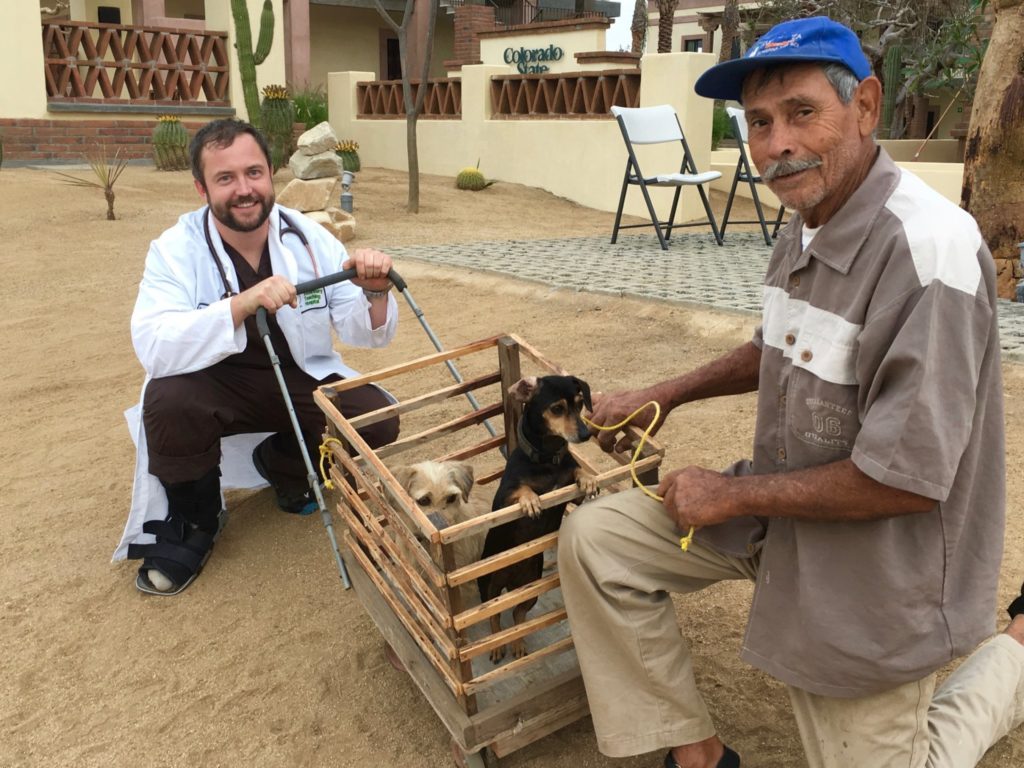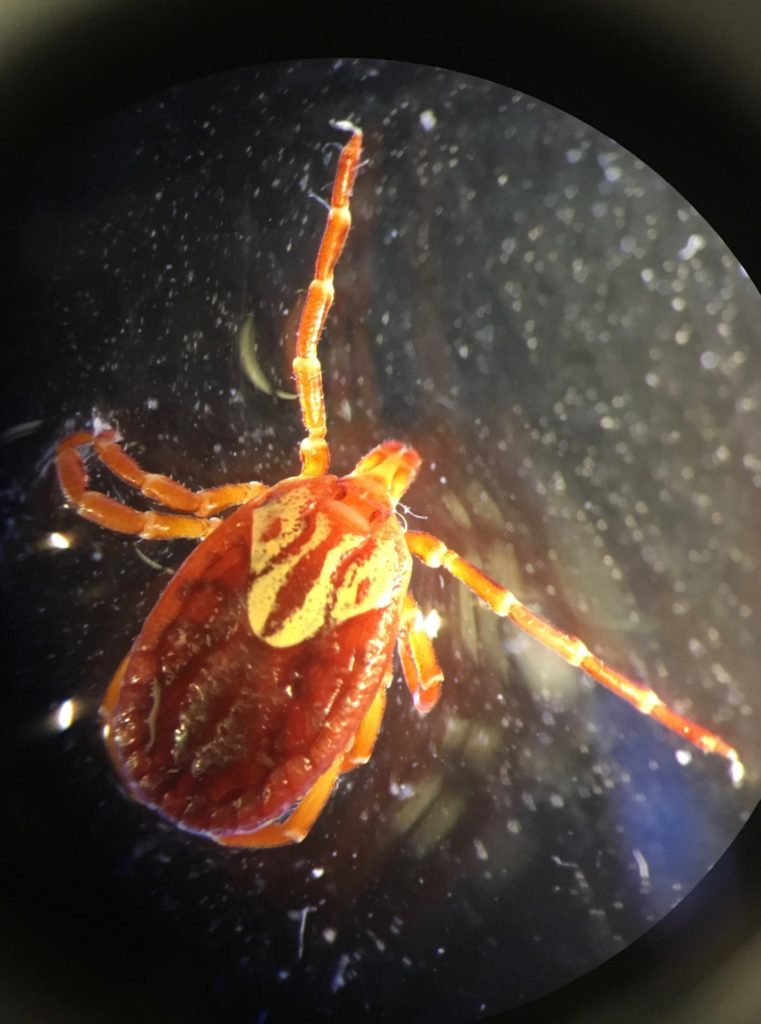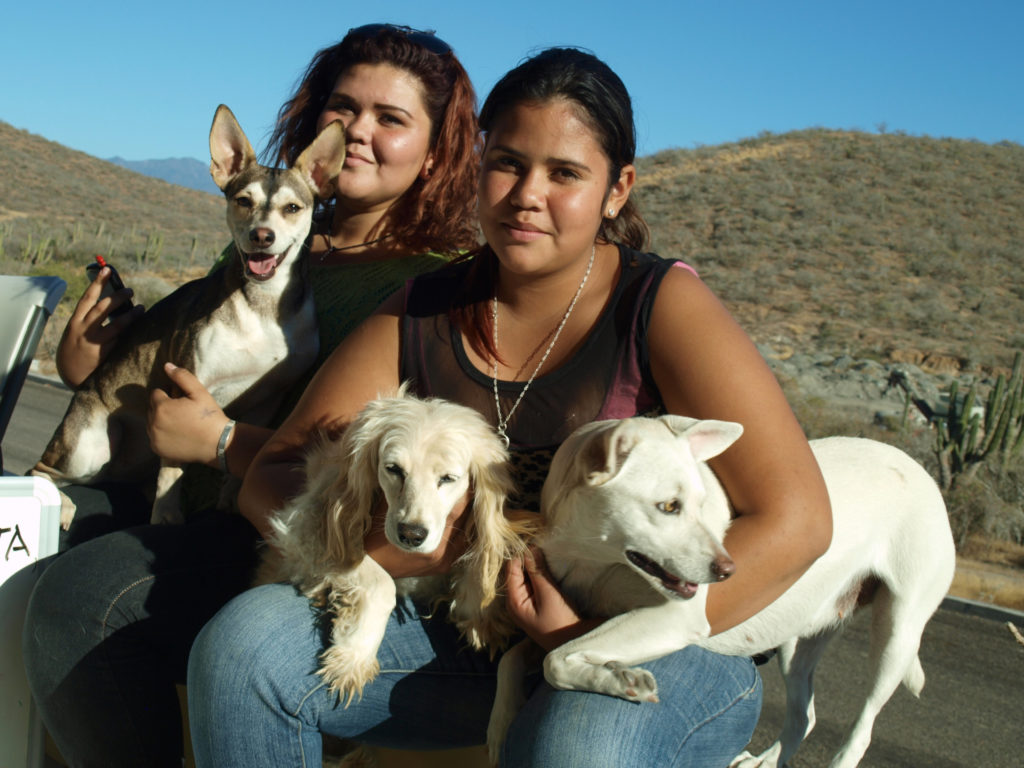
Above: A beach dog watches the sunset in Baja California Sur (Photo by Cody Minor)
Spurred by stories of people in Baja California Sur, Mexico, becoming ill with fevers after tick bites, CSU veterinary researcher Dr. Cody Minor recently worked with public health officials and veterinarians in Todos Santos and La Paz to sample nearly 200 dogs and their parasites to determine the prevalence of tick-borne disease among pets in the region.
Minor’s detective work, accomplished at the Colorado State University Todos Santos Center and in surrounding communities, provides a case study in understanding and interrupting cycles of zoonotic diseases, which infect people and animals.
This research illustrates the critical role of veterinary medicine in linking environmental factors, such as tick populations, to improved wellbeing for animals and people – a sphere of work known as One Health.
Serious diseases with serious consequences

“Our research does have a human health component since people are getting sick,” said Minor, who earned his Doctor of Veterinary Medicine in 2015 and is now working on a master’s degree in clinical sciences. “Mexican veterinarians and human doctors were very interested in the opportunity to look at a cross-section of pets. We had heard a lot of anecdotal evidence that people were coming down with tick-borne diseases like ehrlichiosis and Rocky Mountain spotted fever.”
Working with Dr. David Martínez Salazar in Todos Santos, Minor and other researchers collected blood and parasite samples from 128 dogs. In La Paz, they teamed with Dr. Miguel Angel Espinoza to take samples from 67 dogs. Then, they analyzed the blood to determine if it contained antibodies to zoonotic disease agents, which indicates exposure, and DNA, which indicates active infection in the dog.
Preliminary findings reveal that about half of the dogs in the area carry ticks, and one in five have fleas. About half of the canine population shows evidence of exposure to Ehrlichia canis, a zoonotic pathogen capable of causing illness in people if they are bitten by a tick. Several dogs show exposure to the zoonotic Rickettsia group bacteria, which causes Rocky Mountain spotted fever.
The bacteria responsible for ehrlichiosis and Rocky Mountain spotted fever are transmitted when a tick extracts a blood meal from an infected host and then transfers the infectious agent to a new host when it is time for the parasite to feed again. In this way, infected ticks spread disease among multiple hosts and multiple species.
Ehrlichiosis symptoms range from fever, chills, headache and muscle aches to abdominal pain, diarrhea and weight loss. Rocky Mountain spotted fever symptoms include a rash, fever, chills, headache and muscle aches. The disease is rare but serious, and has increased over the last decade in the United States, especially in eastern Arizona.
“The threat is real. These are serious diseases with serious consequences, but luckily they are easy to prevent, and to treat,” Minor said. He worked with local veterinarians to distribute flea and tick collars to local pet owners in Todos Santos and La Paz. Treatment is usually a 28-day course of the antibiotic doxycycline.
Reaching people through their pets

The public health implications are important and must involve community education to be effective. That’s where Minor shines.
“Cody helped to change the way people think about their animals. They tell me, ‘Before, I didn’t imagine how this can impact us. Now I understand,’” said Amy Rex, a Todos Santos native who works as the educational program coordinator for the CSU center, and assisted Minor with his research and outreach.
As a veterinary student, Minor went to Mexico to study fleas and ticks, and he gathered valuable information about the parasites’ effects on dogs and humans. Yet his impact on the community reaches far beyond one research project.
“What he did down here was monumental,” said Dr. Danielle Straatmann, director of the Veterinary Externship Program at the 2-year-old CSU Todos Santos Center. “His was one of the first projects where people realized we are here for them. The local community saw that the center was accessible and that the students and researchers who visit want to include them. It was a turning point for our center.”
The externship program, now in its third school year, was just getting off the ground in the spring of 2015, when Minor traveled with fellow CSU veterinary students Tiffany Hughes and Malia Paresa to the Todos Santos Center. His tick study began then, and after graduating as a veterinarian, Minor returned with CSU vet student Dana Hill for further research with a Young Investigator grant from Dr. Michael Lappin’s Center for Companion Animal Studies.
“Cody did great work with the community here, in a really thoughtful way, engaging with over 70 different families and their pets, helping them understand more about disease and how they can keep their animals and their families safe,” Straatmann said.
International collaboration is part of CSU’s land-grant mission: extending the knowledge gained from its research to solve community problems. Now, the idea of “community” extends beyond borders and species, a One Health concept exemplified by Minor’s collaboration with Universidad Autónoma de Baja California Sur (UABCS) and local veterinarians and outreach programs.
The project illustrates the university’s investment in One Health: the concept that human, animal and environmental wellbeing are interrelated. “From a One Health lens, it is a perfect example of how the health of animals, people and places are connected,” said Bruno Sobral, director of CSU’s One Health Institute.
For Minor, those lofty ideas translated into simple action at the local level, inviting families to bring their pets to spay and neuter clinics at the Todos Santos Center. “It starts with the kids. So many families came to this project because their kids were involved. It was really great to educate them and learn from them while helping them as well,” he said.
During the Todos Santos externship, senior veterinary students spend a 10-day rotation with UABCS veterinarians and educators Drs. Cristian Arevalos, Alan Ortiz Reyes, and Ramón Cepeda in their teaching hospital clinic, participating in ranch research projects and local outreach programs.
Bound for Mexico, via the Coast Guard

The 2015 trip to Todos Santos was not Minor’s first visit to Mexico. He became interested in the region in 2008, when he was serving in the U.S. Coast Guard and taking classes at Portland State University, and had the chance to study transnational migrant health in Oaxaca.
“We went down to help identify health discrepancies and learn about the Mexican public health system, and through all this work, we encountered so many pets out on the streets that I wanted to go back to Mexico someday and help in a veterinary capacity,” Minor said. “I’ve always been interested in infectious disease research, so when this opportunity in Todos Santos arose, I jumped on it.”
Minor’s journey from undergraduate study at the University of Wyoming, to the Coast Guard, to a veterinary degree took more than a few jumps. He was a 20-year-old studying wildlife biology in Laramie when a Coast Guard recruiter convinced him to enlist. “Maybe I watched too much ‘Baywatch’ as a kid, but I thought it sounded great. And maybe I needed the discipline,” he says with a laugh. “The Coast Guard is a pretty strict, tough way of life.”
He served as a marine science technician and law enforcement boarding officer, dangling from helicopters and climbing up ship ladders as part of a specialized enforcement team off the Oregon and Washington coast.
After six years of service, he accepted an internship at the Oregon Zoo and in 2011, finished his bachelor’s degree in biomedical sciences at CSU. From there, it was straight into the CSU vet school.
“I always wanted to be a veterinarian and at times it was looking pretty bleak while I was trying to piece it all together. I can’t believe how it’s all worked out,” said Minor, who hopes to return to Mexico this summer for further research.
Back in Todos Santos, Straatmann credits Minor for the respectful, genuine way he worked with Todos Santos veterinarians and families, forging lasting connections through caring for pets. “Cody created networks, opportunities and connections for us to engage with the local community,” Straatmann said. “I still hear little kids brag, ‘I’ve already been to the university. My dog got to see Dr. Minor and Amy.’”
Her colleague Amy Rex puts it another way: “Everyone in this town loves Cody. He will have free ice cream here for life.”
About the CSU Todos Santos Center
The Colorado State University Todos Santos Center is the university’s first international location and is core to CSU’s mission of teaching, research, service and outreach.
The center provides opportunities for CSU students and Baja California Sur residents to collaborate with local partners and businesses to identify needs, conduct research, and produce impactful outcomes.
CSU’s vision in Todos Santos is to cultivate generations of global citizens and to be a part of creating thriving communities through collaboration, experience and exchange of knowledge in areas such as agriculture, infectious disease, elementary education, environmental and social sustainability, wildlife ecology, veterinary medicine and public health.